
NY State Emergency Management Offices
With considerable help from Duncan Brown and Fred Gephart--thanks, guys!
| Navigational aids: | Back to JP's Radio Homepage |
| Back to TMC Home Page | |
| Back to TMC History Page | |
At the height of the cold war in the mid-60's, the New York Office of Civil Defense (OCD), later renamed State Emergency Management Office (SEMO), built about a half-dozen Communications Centers distributed around the state. From the beginning, TMC was chosen as the vendor for the communications equipment for the sites. Evidently discussions were proceeding between NY OCD and TMC as early as 1963, as indicated in the Letter & Project Application. It is not clear if this application became an order, but RFQ's were issued in 1964, and it appears that the stations were built and equipped over the next couple of years. They consisted a Master Control Station at Albany, and about a half-dozen Auxiliary Sites scattered around the state, housed in underground bunkers that could sustain about 50-100 people for 2 weeks. These sites were clearly intended to deal with man-made disasters of the nuclear kind. Western New York was served by a site at Batavia, NY, the Hudson Valley by the Poughkeepsie site, northern New York by the Queensbury site, and the Finger Lakes district was served by a site at Newark, NY, the last of the sites to be built.
There is some confusion about the number and location of the Auxiliary-Site bunkers that were eventually built. From the TMC literature (see SYM-2007, Figure 1-1), in addition to Master Control at Albany, there were seven sites originally planned, at Saratoga, Poughkeepsie, Bronx, Binghampton, Newark, Sonyea, and Marcy.

Present-day State Emergency Management Offices are located as shown in the map above, a main office at Albany, and regional offices for each of the five Management Districts. Two of these sites (Newark and Poughkeepsie) were in the original plan. Examination of satellite views of the Queensbury site indicates that it includes a bunker and antennas installed in the 60's.
Before the Newark site was finished, the state decided the centers weren't needed, or perhaps ran out of money to complete them, and cancelled the program. However, it turned out to be cheaper to finish the Newark site than to pay for canceling the contract. Around 1970, the state decided to reactivate all of the sites.
At about the same time a group (including a present AWA museum curator) was starting up an amateur radio club in the Newark area, and they were able to get some space in the Newark SEMO facility for locating ARES/RACES equipment, and to hold meetings. The site was apparently built with ARES/RACES in mind, as at the top of the 200' tower is a 4 boom 2M Yagi array. And about half way up the tower there is a 5 el 6M Yagi antenna. Amateur and AWA presence in the Newark bunker led to the donation to the AWA Museum of the TMC HF communications equipment.
The site originally planned for Sonyea was actually located in Batavia, NY behind the NY School for the Blind. The communication equipment at this site was eventually turned over to the local radio club, where it supported ARES/RACES activities. Eventually, SEMO decided to discard the equipment, and a local ham saved it from the dump. In September 2012, this equipment, together with manuals and spares, was relocated to my QTH in North Carolina, where it is currently awaiting restoration.
It seems likely that the site originally planned for Saratoga was actually located at Queensbury. Examination of satellite views of this site clearly shows the head-end of the bunker, as well as radio masts.
At some point, the state decided to try to save money on the sites by turning off the power. However, the sites were below grade, so this decision turned out to be a disaster--some of the sites flooded!
The sites in Queensbury, Newark, and Poughkeepsie are still in use today, housing modern communications equipment and various other facilities. See below for a virtual tour of the Newark site.
The radio installation at the Master Control Site at Albany was quite a bit more elaborate than those at the Auxiliary Sites. There were two transmitters, an SBT-1KS (like the ones at the Aux Sites) and a synthesized SBT-1KS (with SBG-1 exciter). There were two "main" receivers, both GPR-92A's, and 2 "plug-in" receivers, FFR's. Also installed were a variety of tone keyers and decoders, teletype and FAX equipment, patch panels, antenna tuners, dummy loads, and much more. With the exception of some of the RTTY interface gear, most of the equipment was furnished and installed by TMC.
You can read the original Request for Quotation for the Albany installation here: Specification for Emergency Communications System. It's an interesting document, and it's pretty clear that TMC was the intended vendor from the beginning.
Below are some photos of the Albany installation:
Auxiliary sites included a diesel generator set and a communications facility consisting of an SBT-1K transmitter, GPR-92A and FFR receivers, MSR sideband adapter, TTY and FAX equipment.. An illustration of a typical equipment arrangement (left) and a block diagram of the communications equipment (right) are shown below.
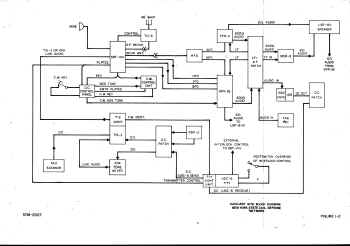 |
|
| Sketch of typical equipment arrangement in an Auxiliary Site Radio Room. | Block diagram of Aux Site radio equipment. |
Receiving equipment consisted of an HFD antenna coupler driving an FFR and a GPR-92A (originally specified as GPR-92) receiver. Line outputs from the two receivers were routed through a custom patch panel, through an MSR-9 sideband adapter to an LSP loudspeaker. Speaker outputs from the radios were routed directly to the speaker. The audio patch panel also routed audio to the FAX receiver, and to a Tele-Signal 102A Tone Converter, through a T-S 109 Switch to a custom DC patch panel, thence to the TMC-custom-built TTY Control Unit inside the UGC-6 (KSR28) teletype machine. The HFO, IFO, and BFO for the GPR-92A could be supplied from the VOX-5.
The station transmitter was an SBT-1KV, comprising a VOX-5, SBE-6, and PAL-1KA, with ATS-2 antenna control and tuning units. Operational modes included SSB speech, RTTY, FAX, and CW. The station had ISB capability, so may have operated RTTY and SSB voice simultaneously. For RTTY, the KSR28's current loop, routed through the TTY Control Unit, either directly to a TIS-3 Tone Keyer, or through a Tele-Signal 101A Keyer. For FAX operation, the FAX Scanner's DC output drove the TIS-3, which produced audio tone data for transmission. And, for CW, a key was routed through a TMC-custom-built CW Control Unit, which keyed the transmitter, and produced a side-tone that could be heard through the GPR-92A's audio system.
Below are a couple of TMC photos of the equipment at Auxiliary Sites:
Below are some photos of the equipment originally located at Batavia:
Duncan Brown, a curator at the AWA Museum in Bloomfield NY and the person responsible for working on the Museum's TMC equipment from the Newark site, kindly visited the site and took a bunch of great photos. Enjoy the tour below, with many thanks to Duncan!
Duncan managed to get into the underground bunker recently, sketched out a floorplan of the facility (using the floor tiles for dimensions!), and took a bunch of photos. A slightly redrawn diagram of the bunker is shown below:

The Stairwell lies directly below the small red-brick entrance building, shown in the photos above. Duncan noted that the Operations Room has 32 desks, all with phones and four with GE Radio remote controls. Desks have signs, such as: En Con, Soc. Serv., Sal. Army, Guard, St. Pol., FBI, CAP, Fire, AG/Mkts, Labor, DOT, USDA.
Below is a gallery of photos that Duncan took of the various rooms in the bunker:
Thanks to google maps and its satellite view function, it's possible to play a geeky version of Where's Waldo with the OCD/SEMO locations. Below is a list of addresses for the headquarters and five regional offices of the NY Emergency Management Office, along with satellite photos and links to Google maps:
| Headquarters |
NY State Office of Emergency Management
1220 Washington Ave
Bldg #22 Ste 101
Albany, NY 12226-2251
518-292-2200
Link
to Google Maps
If you follow the google maps link, you can see a couple of vertical antennas just north of the building in the lower left center, evidently the headquarters building. |
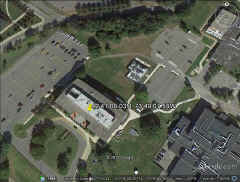
|
| Region I |
Suffolk State Office Building
250 Veteran's Memorial Highway
Room 4A7 Hauppage, NY 11788-5506
518-292-2411
Link
to Google Maps
I can't find any evidence of a bunker or radio tower at this address.. if you live near Hauppage, see what you can find there! |
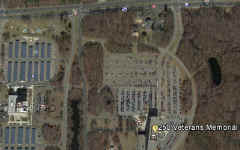
|
| Region II |
171 Cheney Drive
Poughkeepsie, NY 12601-1011
518-292-2421
Link
to Google Maps
Look to the NNW of the address; there's a wide, curving driveway off Cheney Drive, and if you zoom in, you can see the entrance to the bunker, built into the hillside. Just to the west of the entrance is a large radio tower. |
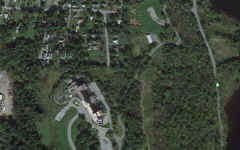
|
| Region III |
5 Fox Farm Road
Queensbury, NY 12804-1107
518-292-2430
Link
to Google Maps
The Queensbury site is evidently still in use, and it's pretty easy to see the entrance to the bunker, just at the SE edge of the parking lot left of center of the photo. The tower is not easy to see in this photo (it's easier to spot in the Google Maps image), but you can see its shadow. |
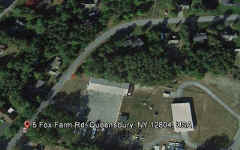
|
| Region IV |
10 Adler Dr. Suite 103
East Syracuse, NY 13057
518-292-2441
Link
to Google Maps
It appears that this site may no longer be the Region IV headquarters. Google maps thinks it's a lawyers' office. |
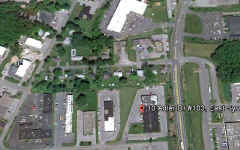
|
| Region V |
1144 East Union Street
Newark, NY 14513-9802
518-292-2451
Link
to Google Maps
The Neward site was temporarily closed in 2010 because of water leaks. However, nothing has been removed from the site (see photos above). If you examine the photo to the right, or visit the google map reference, you can easily see the tower and surrounding buildings, as well as the entrance from NY Hwy 31. |
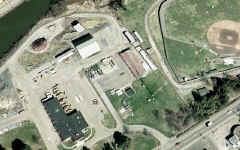
|
The Batavia Auxiliary Site has been largely abandoned. It's also quite difficult to find. Fortunately, Duncan Brown has been there, and provided the following directions and commentary:
In the image above, the NY School for the Blind is at the lower center of the image. State School Rd is upper center, running right to left, then curving up to a parking lot. The entrance to the bunker is under the big tree at the NE corner of this lot.